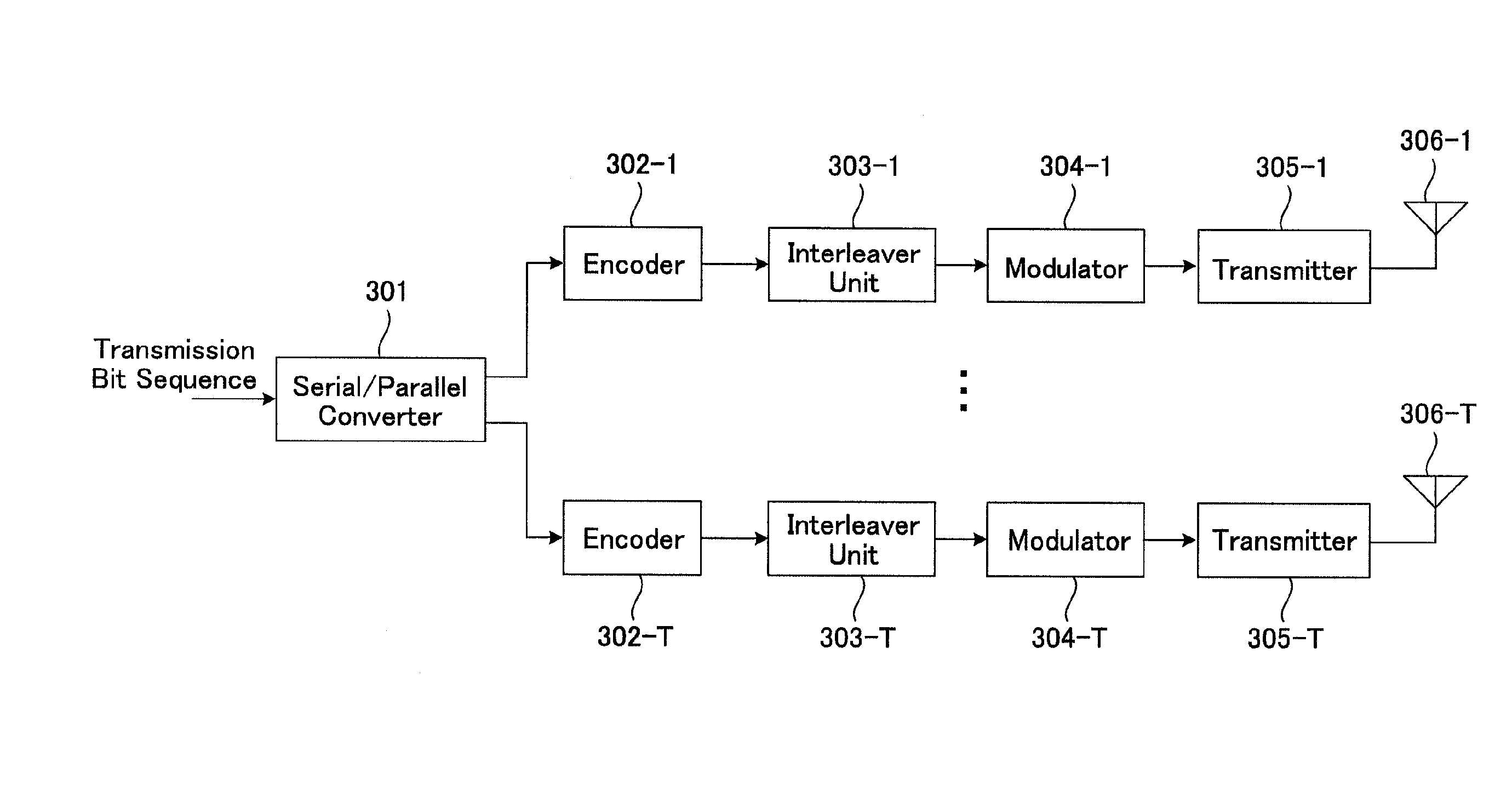Receiving apparatus, receiving method and communication system
a technology of receiving apparatus and receiving method, applied in the field of receiving apparatus, receiving method and communication system, can solve the problems of degrading reception performance and a large amount of computing operation, so as to improve the accuracy of bit log likelihood ratio, improve reception performance, and reduce the amount of computing operation
- Summary
- Abstract
- Description
- Claims
- Application Information
AI Technical Summary
Benefits of technology
Problems solved by technology
Method used
Image
Examples
embodiment 1
[0138]FIG. 1 is a block diagram showing a configuration of a transmitting apparatus in the first embodiment. The transmitting apparatus includes a serial-to-parallel converter 301, encoders 302-1 to 302-T, interleaver units 303-1 to 303-T, modulators 304-1 to 304-T, transmitters 305-1 to 305-T and transmitting antennas 306-1 to 306-T. A transmission bit sequence is serial-to-parallel converted by serial-to-parallel converter 301 so as to be divided into T bit sequences. The bit sequences are error correction coded by corresponding encoders 302-1 to 302-T, respectively, using, for example, convolution coding, turbo coding, LDPC (Low Density Parity Check) coding, or the like, and formed into encoded bit sequences. The encoded bit sequences are interleaved by interleavers 303-1 to 303-T, respectively. The encoded bit sequences after interleaving are mapped on modulation symbols such as QPSK (Quadrature Phase Shift Keying), 16QAM (Quadrature Amplitude Modulation) or the like, by modulat...
embodiment 2
[0163]In the first embodiment, the method of calculating bit LLRs when combined with error correction was illustrated. However, when the optimal bit LLR is determined, the minimum metric among inverted bit sequences is needed so that computing operation as much as that of MLD is required. When MLD with transmitted signal candidates reduced in number is used, if any inverted bit sequence remains in the candidates, it is possible to use the minimum metric of the remaining inverted bit sequence in calculating bit LLRs. However, in the first embodiment, concerning transmitted signal candidates, the transmitted signal candidates were searched out in order to determine the maximum likelihood sequence. However, in this case, there is a possibility that no inverted bit sequence will remain in the transmitted signal candidates, and if this case happens, it is impossible to calculate any bit LLR. In the second embodiment, a narrowing down method of transmitted signal candidates will be descri...
embodiment 3
[0173]In the third embodiment, a method of calculating bit LLRs in a simplified manner, using a step size will be described.
[0174]Described in the third embodiment is a method of calculating bit LLRs by determining inverted bit sequences of which the metric needs to be generated, using the step size generated in the first embodiment, and generating the metrics of the determined inverted bit sequences.
[0175]FIG. 7 is a block diagram showing a configuration of a signal detector 403 in the third embodiment. The difference from the signal detector 403 in the second embodiment is that a step size is output from updating value processor 604 to likelihood processor 606. First, likelihood processor 606 selects the transmitted signal candidate producing the minimum metric and determines the metric of the inverted bits of the selected transmitted signal candidate by considering the step size. Therefore, updating value processor 604 and likelihood processor 606 will be mainly described herein....
PUM
 Login to View More
Login to View More Abstract
Description
Claims
Application Information
 Login to View More
Login to View More - R&D
- Intellectual Property
- Life Sciences
- Materials
- Tech Scout
- Unparalleled Data Quality
- Higher Quality Content
- 60% Fewer Hallucinations
Browse by: Latest US Patents, China's latest patents, Technical Efficacy Thesaurus, Application Domain, Technology Topic, Popular Technical Reports.
© 2025 PatSnap. All rights reserved.Legal|Privacy policy|Modern Slavery Act Transparency Statement|Sitemap|About US| Contact US: help@patsnap.com



